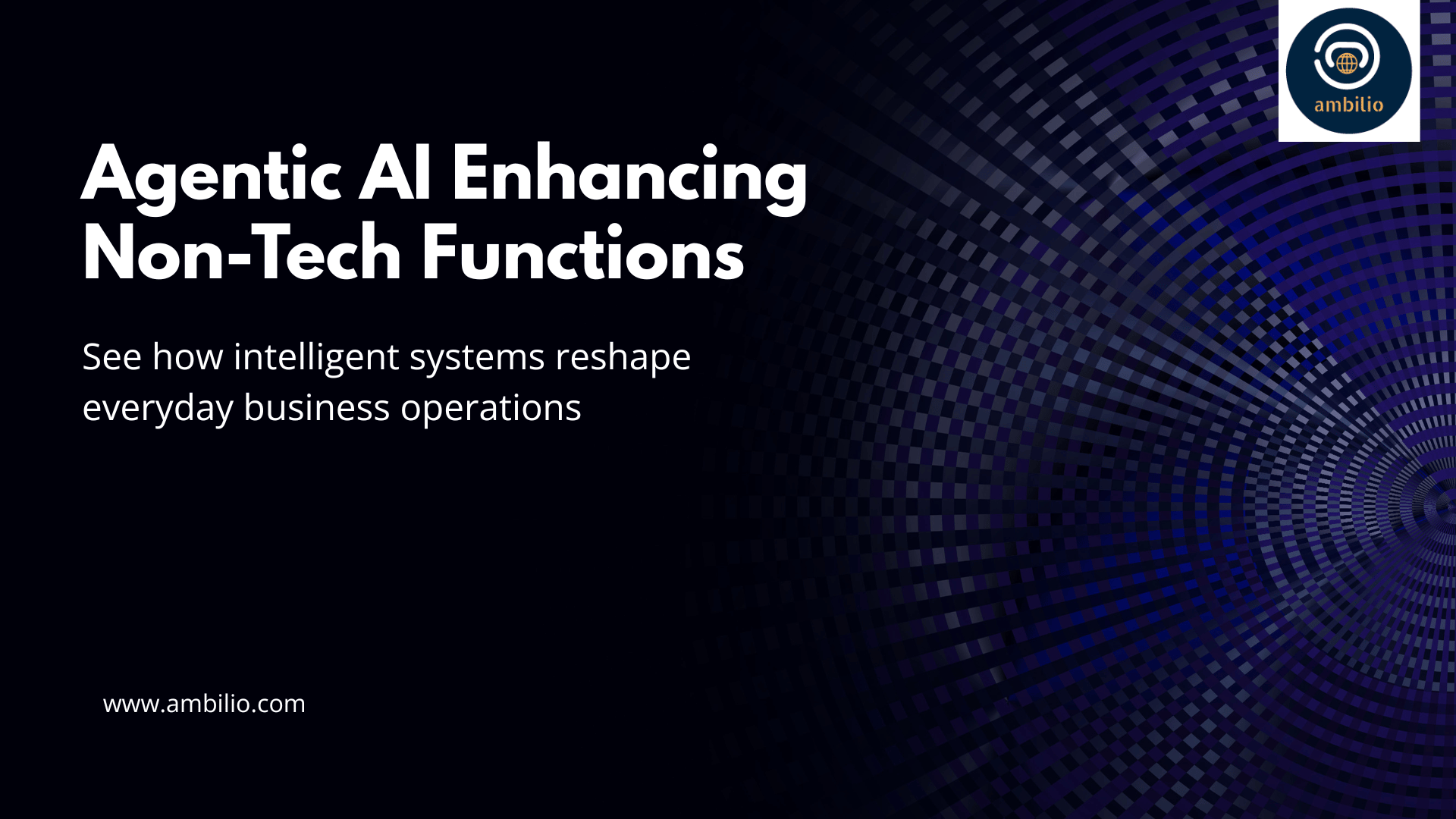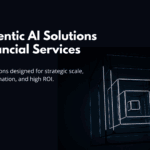Artificial Intelligence has steadily integrated into our professional routines, evolving far beyond simple chatbots and recommendations. A major advancement is agentic AI—systems capable of autonomously executing tasks, making context-aware decisions, and managing multi-step workflows without constant human input. Unlike traditional automation, agentic AI is goal-oriented, adaptive, and can handle complex reasoning, making it ideal for non-tech business functions like HR, finance, marketing, operations, and customer support. This article discusses how agentic AI can enhance these areas by automating routine processes, improving efficiency, and enabling better decision-making. Without naming specific tools, it presents practical use cases and the real-world impact of adopting such intelligent systems.
Understanding Agentic AI in Simple Terms
Agentic AI refers to systems that can perceive an environment, set goals, plan actions, and execute those actions with a level of autonomy. Think of these as intelligent digital assistants that don’t just wait for commands, but can proactively perform tasks, adapt based on real-time data, and learn from outcomes. These systems do not require constant programming or manual configuration. Instead, they operate using high-level instructions and interact with software, platforms, or documents in a way similar to human employees.
In non-technical business environments, where tasks are often routine, repetitive, or involve multiple systems, agentic AI can offer a major efficiency boost. It is not meant to replace human workers but rather to augment their work by handling the repetitive parts and enabling staff to focus on strategy, relationships, and problem-solving.
Applications in Human Resources (HR)
Human Resources is a business area that involves extensive documentation, compliance, employee communication, and process workflows. Agentic AI can play a significant role here by automating the following:
- Employee Onboarding: From generating offer letters and managing document submissions to setting up accounts and assigning training modules, agentic AI can coordinate the entire onboarding journey. Once an offer is accepted, the AI can trigger and complete each subsequent step without manual follow-up.
- Leave and Policy Management: Instead of employees emailing HR for leave balance or company policy queries, an agent can handle such queries conversationally and access policy documents, calculate balances, and offer clear, consistent responses.
- Performance Management Assistance: Scheduling review meetings, gathering self-assessment inputs, and generating performance reports can be managed by AI agents, reducing administrative load on HR managers.
- Employee Exit Formalities: Exit interviews, clearance forms, feedback collection, and revocation of accesses are structured processes that can be orchestrated end-to-end using agentic systems.
Transformation in Finance and Accounting Functions
Finance departments often deal with structured data, recurring cycles, and compliance-heavy reporting. These characteristics make them ideal for agentic AI deployments.
- Invoice Processing and Reconciliation: AI agents can extract data from invoices, match them with purchase orders, and flag discrepancies for human review. They can also post entries into financial systems automatically.
- Expense Management: Employees can submit expense details via email or a form, and the AI can validate receipts, check policy violations, and initiate reimbursement approvals.
- Budget Monitoring and Alerts: AI systems can track budget utilization in real-time, flag overspending, and recommend budget reallocations based on spending trends.
- Compliance Reporting: Creating reports for audits, taxation, and regulatory submissions often requires fetching data from multiple systems. AI agents can compile, format, and validate these reports efficiently.
Enhancing Customer Support and Service Operations
Customer service often involves handling a large volume of queries that are repetitive and structured. While chatbots have been around for a while, agentic AI offers more comprehensive task execution.
- Automated Ticket Resolution: AI agents can read incoming queries, classify them based on priority and category, fetch relevant knowledge base content, or even complete backend actions like refund initiation or delivery tracking.
- Follow-Up and Escalation: When human intervention is needed, agents can automatically escalate to the right team member, book a callback, or send a summary of the issue to facilitate resolution.
- Feedback Collection: After query resolution, agents can send personalized feedback forms, analyze responses, and generate customer satisfaction reports.
- Service Onboarding and Walkthroughs: For new customers using a digital service or portal, an AI agent can guide them through setup processes, explain features, and handle account customization.
Productivity in Marketing and Sales Functions
Sales and marketing require a blend of creativity, outreach, and data analysis. Agentic AI can support the operational side of these activities.
- Campaign Setup and Monitoring: Once a marketing manager defines a goal (e.g., a product launch), an AI agent can generate ad creatives, set up campaigns across platforms, monitor performance, and pause underperforming ads—all based on predefined guidelines.
- Lead Qualification: Instead of manual review, AI can scan incoming leads, extract relevant data from web forms or emails, score leads based on preset criteria, and assign them to the right salesperson.
- Content Research and Drafting: For blogs, newsletters, and social media, agents can research trending topics, draft outlines, and even write first drafts. The human team can then review and personalize the content.
- CRM Updates and Notifications: AI agents can record meeting notes, update customer relationship management systems, and notify salespeople of important follow-ups or actions required.
Operations and Internal Workflow Management
Business operations include a wide range of internal processes—from procurement to compliance, team coordination, and vendor communication. Agentic AI offers valuable capabilities these non-tech business functions as well.
- Procurement Automation: AI agents can issue purchase requests, get approvals, compare vendor quotes, and track order status without human prompting.
- Meeting and Calendar Management: Coordinating meetings across teams, time zones, and departments can be handled by AI that schedules, reschedules, sends reminders, and prepares meeting agendas.
- Project Coordination: For teams working on cross-functional projects, agentic systems can assign tasks, monitor deadlines, generate progress reports, and nudge team members on pending items.
- Policy Enforcement and Compliance: Agents can track adherence to internal policies, monitor compliance-related checklists, and generate exception reports or alerts for violations.
Considerations for Implementation
While the benefits are substantial, it’s important to start with clear goals. Non-tech business functions should begin with small, clearly defined processes that have repeatable steps. It is also essential to ensure that data access permissions, security protocols, and oversight mechanisms are in place. Human supervision during the initial phase ensures the system learns effectively and earns the trust of team members.
Agentic AI does not demand coding expertise or technical backgrounds. Most modern systems provide user-friendly interfaces and natural language interactions, allowing business users to configure and deploy automation with minimal support.
Final Thoughts
The rise of agentic AI marks a major shift in how non-tech business functions can operate. What was once considered complex and time-consuming can now be managed by intelligent systems that adapt, learn, and act autonomously. By embracing these capabilities, businesses can reduce routine workloads, enhance accuracy, and allow teams to focus on strategy and innovation. As organizations begin to explore these possibilities, the real transformation will come not just from adopting new tools, but from reimagining what work looks like when intelligence is embedded across everyday processes.



